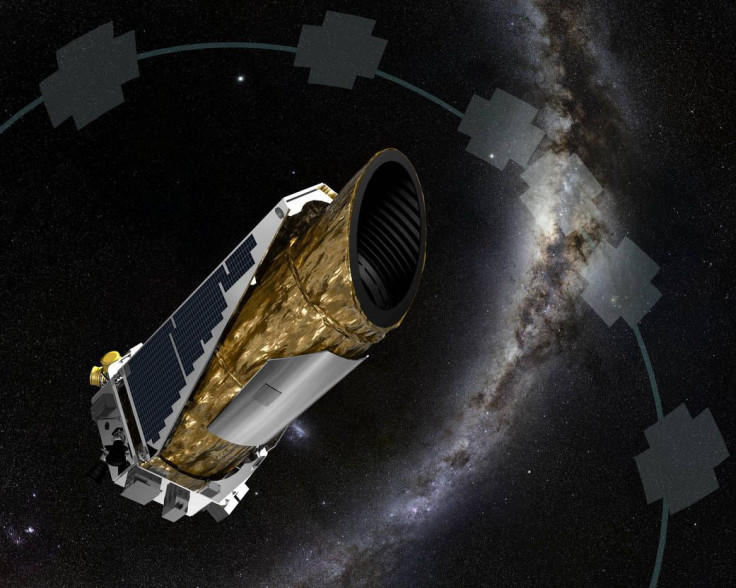SETI Searches 'Alien Megastructure' For Signs Of Intelligence; Results Of The 'Most Mysterious Star In The Universe' Could Come This Week

The Search for Extraterrestrial Life (SETI) is training its sights on a possible alien megastructure surrounding a distant star known as KIC 8462852 that has captured the imagination following an article published in the Atlantic. And while all involved think aliens are the least likely scenario, the results of the first scan of the universe could be revealed by the end of the week.
The extraordinary star with a very boring name is notable for its odd dimming patterns, which have sparked the imagination of stargazers. So now the Search for Extraterrestrial Life, immortalized in the movie "Contact," is pointing its Allen Telescope Array at the star and searching for any sign of intelligence. In an interview with International Business Times, Seth Shostak, senior astronomer and director of the center for SETI Research, revealed SETI could have answers as early as Friday.
"Our observing guy, Jon Richards, has been for the last four or five days been using the array, which we use to scrutinize the sky, looking for signals," Shostak said. "So far, the aliens have been coy, but he's going to re-observe and try to improve his sensitivity later this week."
As is typically true of any SETI search, you can probably guess the outcome. "I suspect what will happen is that, later this week, we'll announce that we looked at it over this range of frequencies using the ATA and we didn't find any signals," Shostak said.
And yet, that's the purpose of SETI: to be there when the signal arrives, from wherever or whoever in the cosmos.
Aliens or not, KIC 8462852 is worthy of attention. Astronomers and citizen scientists began to notice something pretty odd about this star. The Kepler Space Telescope observed the star for four years and found multiple dips in brightness, suggesting a possible ring of debris around the star. That would be fine for a young star, but this star is older. There's an absence of infrared light, caused by surrounding dust, which adds another layer of mystery to the star. Additional oddities were noted -- if the debris was relatively old, it would have been gone by this point -- which left astronomers scratching their heads.
Yale astronomer Tabetha Boyajian is the lead author of the paper detailing KIC 8462852's odd dimming pattern. Boyajian and her co-authors suggested a passing star dragging a group of comets to the star as a possible explanation. Penn State astronomer Jason Wright had another suggestion: aliens.
Based on Wright's blog post, the suggestion of an alien megastructure was more of a hypothetical one. "The idea is that if advanced alien civilizations build planet-sized megastructures — solar panels, ring worlds, telescopes, beacons, whatever — Kepler might be able to distinguish them from planets," Wright wrote in a blog post. Wright even says "you should reserve the alien hypothesis as a last resort."
Wright highlighted how weird the star was and, along with Boyajian, requested time with the Green Bank Telescope to observe the star. The narrative changed quickly after the Atlantic article followed by sensational reports of the alien megastructure theory.
"When you hear hoof beats, think horses not zebras," Shostak said in regards to choosing the more familiar theory rather than the more extraordinary theory. A Dyson Sphere, or swarm, has been a popular theory of alien intelligence based on humanity's consumption of power. As humanity has become more technology advanced, there has been an increased need for power. With power maxed out on Earth, one way to get power would be to create a swarm of satellites that could harvest the sun's power.
"What you're seeing is the light changes due to the construction. That's not a signal; that's not a deliberate message saying 'Hey, we built this thing,'" Shostak said.
When news broke of the mysterious Kepler star, SETI was able to power up the ATA to search for any potential signals that could indicate intelligent life. Because there's less noise in the microwave frequency, weaker signals can be detected by setups like the ATA and the Green Bank Telescope, according to SETI.
As SETI uses the ATA to survey billions of frequencies, there are plenty of variables to indicate the mystery will remain unsolved. If potential life didn't bother to set up a transmitter, or established one that delivered weak signals, a radio telescope wouldn't detect life around KIC 8462852. Larger radio telescopes, like the Very Large Array in New Mexico or the Arecibo Observatory in Puerto Rico, could be used to gather more data about the star. Future telescopes, like the James Webb Space Telescope, could possibly be used to detect infrared light if there is a structure, notes Shostak.
© Copyright IBTimes 2024. All rights reserved.






















